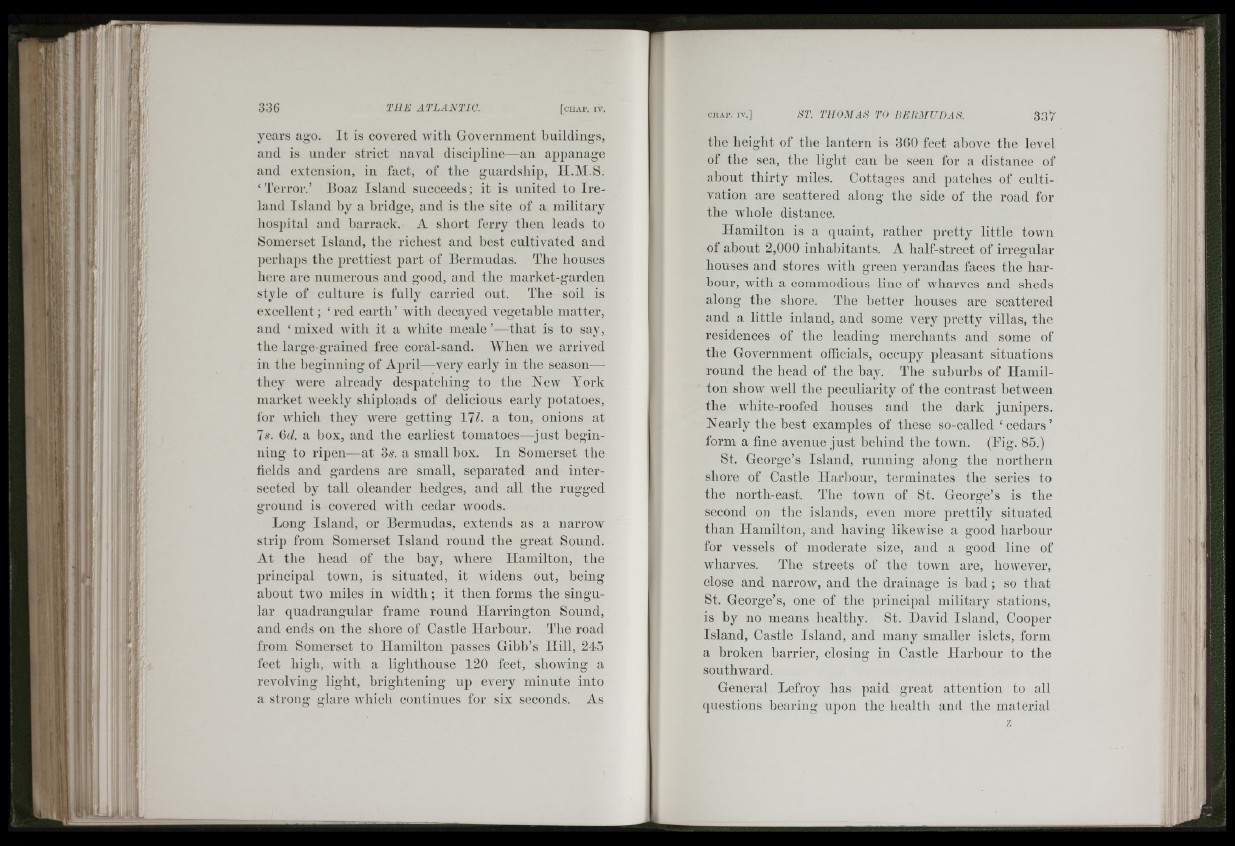
il a
mm
-ll r Ba
I
!
336 THE J 7 ’LyliV3'/C. [ c h a p . IV.
years ago. It is covered with Government buildings,
and is under strict naval discipline—an appanage
and extension, in fact, of tbe guardsbip, II.M.S.
‘Terror.’ Boaz Island succeeds; it is united to Ireland
Island by a bridge, and is tbe site of a. military
hospital and barrack. A sbort ferry tben leads to
Somerset Island, tbe richest and best cultivated and
perba[)s tbe prettiest part of Bermudas. The bouses
here are numerous and good, and the market-garden
style of culture is fully carried out. The soil is
excellent; ‘ red earth’ with decayed vegetable matter,
aud ‘ mixed Avith it a white meale ’—that is to say,
the large-grained free coral-sand. Mdien Ave arrived
in tbe beginning of April—very early in tbe season—
tliey were already despatching to tbe New York
market Aveekly shiploads of delicious early potatoes,
for Avliicb they Avere getting 17/. a ton, onions at
7s. Qd. a box, and tbe earliest tomatoes—just beginning
to ripen—at 2>s. a small box. In Somerset tbe
tields and gardens are small, separated and intersected
by tall oleander hedges, and all the rugged
ground is covered Avith cedar woods.
Long Island, or Bermudas, extends as a narroAV
strip from Somerset Island round the great Sound.
At tlie head of the bay, Avhere Hamilton, the
principal toAvn, is situated, it Avidens out, being
ahout two miles in Avidth; it then forms the singular
quadrangular frame round Harrington Sound,
and ends on the shore of Castle Harbour. The road
from Somerset to Hamilton passes Gibli’s Hill, 245
feet high, Avith a lighthouse 120 feet, shoAving a
revolving light, brightening up every minute into
a strong glare Avhich continues for six seconds. As
CHAP. IV .] ST. THOMAS TO HERMUDAS. 337
the height of the lantern is 360 feet ahove the level
of the sea, the light can be seen for a distance of
about thirty miles. Cottages and patches of cultivation
are scattered along tbe side of tbe road for
tbe Avbole distance.
Hamilton is a quaint, rather pretty little town
of about 2,000 inhabitants. A half-street of irregular
bouses and stores Avith green verandas faces tbe harbour,
Avitb a commodious line of Avbarves and sheds
along tbe shore. Tbe better houses are scattered
and a little inland, and some very pretty villas, tbe
residences of tbe leadmg merchants and some of
the Government officials, occupy pleasant situations
round the head of tho bay. The suburbs of Hamil-
ton show Avell tbe peculiarity of tbe contrast betAveen
the wbite-roofed houses and tbe dark junipers.
Nearly the best examples of tliese so-called ‘ cedars’
form a tine avenue just behind tbe toAvn. {Lig. 85.)
St. George’s Island, running along tbe northern
shore of Castle Harbour, terminates the series to
tbe north-east. The toAvn of St. George’s is the
second on the islands, even more prettily situated
than Hamilton, and having likewise a good harbour
for vessels of moderate size, and a good line of
wharves. The streets of the town are, however,
close and narrow, and the drainage is bad ; so tbat
St. George’s, one of the principal military stations,
is by no means healthy. St. David Island, Cooper
Island, Castle Island, and many smaller islets, form
a broken barrier, closing in Castle Harbour to tbe
southward.
General Lefroy bas paid great attention to all
questions bearing upon tbe bealtli and tbe material
■UW C I